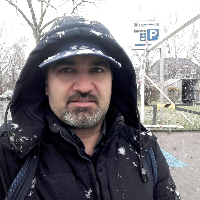Assessment of soil depth temperature variations pattern and a numerical model for its calculation (Case Study: Tehran)
Author(s):
Abstract:
Introduction Soil temperature and its variations over time and space is one of the most important factors which not only affect matter and energy exchanges in soil, but rate and direction of all physical processes, directly or indirectly are related to soil temperature. This parameter is a significant factor in agro-meteorology which most of the time is more important than air temperature for plants, from environmental point of view. Soil Temperature assessment at different depths requires knowledge of its physical characteristics such as thermal conductivity, soil specific heat capacity, diffusion coefficient and etc. when these parameters are not available, it’s impossible to access the temperature vertical distribution in soil profile and needs to use simple methods. Statistical and empirical methods which are able to show acceptable results in soil temperature assessment can be a proper way to calculate this parameter in location without soil temperature measurements. So, regarding to importance of soil depths temperature calculation in agriculture, engineering and etc., the main objective of this study is determining a numerical model for estimating soil depths temperature. 2-Methodology In this study, soil depths temperature variations pattern were determined based on measured data, firstly. Then, performance of an empirical model for estimating the soil depths temperature was tested. To do so, monthly and annual temperatures of 5, 10, 20, 30, 50 and 100 cm of soil in Mehrabad synoptic station at 3 times in a day during the 2008 (6:30, 12:30, 18:30 at local time) were extracted from Iran Meteorological Organization and temperature pattern of each depth was studied. For calculating temperature in different depths, temperature of 5cm was used as base temperature and temperature of other depths was estimated by using sinusoidal equation. For calibrating the estimated and measured temperatures, statistical methods such as correlation coefficient and Nash-Sutcliffe efficiency coefficient were applied. 3-Disscusion According to the results soil temperature indicates similar monthly pattern in all depths, so that maximum and minimum temperature is related to July-August and January-February-December, respectively. Also, Hourly soil depths temperature illustrated that in near surface depths (5cm) maximum temperature occurs in middle of the day (12:30), while minimum temperature is recorded after sunrise (6:30). At the depth of 10cm, maximum temperature occurs at 18:30 because of a time lag in temperature transfer from surface to depth. Generally, temperature behavior of different depths demonstrated 2 distinct patterns during the year; in warm period, temperature decreases from top to depth, so that maximum and minimum temperature was recorded at 5 and 100 cm, respectively. But in cold season, trend of temperature variations is completely visa versa and temperature increases with depth. In addition, reconstructed soil temperature data display that there is a negligible difference between estimated and recorded temperature data, especially at the depths which are near the base surface (5cm), so that correlation coefficient between these two parameters varies from 0.99 at the depth of 10cm and 0.89 at the depth of 100cm and is significant at 99% level. Moreover, result of Nash-Sutcliffe efficiency coefficient varies from 0.9963 to 0.9114 which shows high efficiency of the empirical model. 4-conclusion The main objective of this study is analyzing an empirical model for estimating the soil depths temperature in regions which are not under cover of synoptic stations. Generally, results demonstrated that there is significant correlation between estimated and recorded data. Also, Calibration of the correlation and Nash-Sutcliffe coefficients showed that empirical equation has proper efficiency for calculating soil depths temperature.
Keywords:
Language:
Persian
Published:
Geography and Environmental Planning, Volume:26 Issue: 3, 2015
Page:
17
https://magiran.com/p1456397
دانلود و مطالعه متن این مقاله با یکی از روشهای زیر امکان پذیر است:
اشتراک شخصی
با عضویت و پرداخت آنلاین حق اشتراک یکساله به مبلغ 1,390,000ريال میتوانید 70 عنوان مطلب دانلود کنید!
اشتراک سازمانی
به کتابخانه دانشگاه یا محل کار خود پیشنهاد کنید تا اشتراک سازمانی این پایگاه را برای دسترسی نامحدود همه کاربران به متن مطالب تهیه نمایند!
توجه!
- حق عضویت دریافتی صرف حمایت از نشریات عضو و نگهداری، تکمیل و توسعه مگیران میشود.
- پرداخت حق اشتراک و دانلود مقالات اجازه بازنشر آن در سایر رسانههای چاپی و دیجیتال را به کاربر نمیدهد.
In order to view content subscription is required
Personal subscription
Subscribe magiran.com for 70 € euros via PayPal and download 70 articles during a year.
Organization subscription
Please contact us to subscribe your university or library for unlimited access!


